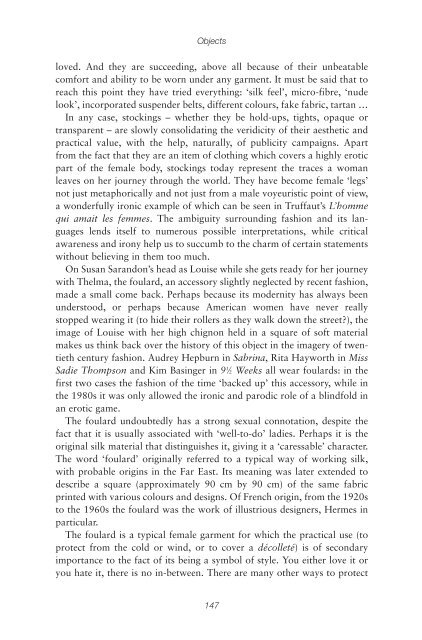You also want an ePaper? Increase the reach of your titles
YUMPU automatically turns print PDFs into web optimized ePapers that Google loves.
Objects<br />
loved. And they are succeeding, above all because of their unbeatable<br />
comfort and ability to be worn under any garment. It must be said that to<br />
reach this point they have tried everything: ‘silk feel’, micro-fibre, ‘nude<br />
look’, incorporated suspender belts, different colours, fake fabric, tartan …<br />
In any case, stockings – whether they be hold-ups, tights, opaque or<br />
transparent – are slowly consolidating the veridicity of their aesthetic and<br />
practical value, with the help, naturally, of publicity campaigns. Apart<br />
from the fact that they are an item of clothing which covers a highly erotic<br />
part of the female body, stockings today represent the traces a woman<br />
leaves on her journey through the world. <strong>The</strong>y have become female ‘legs’<br />
not just metaphorically and not just from a male voyeuristic point of view,<br />
a wonderfully ironic example of which can be seen in Truffaut’s L’homme<br />
qui amait les femmes. <strong>The</strong> ambiguity surrounding fashion and its languages<br />
lends itself to numerous possible interpretations, while critical<br />
awareness and irony help us to succumb to the charm of certain statements<br />
without believing in them too much.<br />
On Susan Sarandon’s head as Louise while she gets ready for her journey<br />
with <strong>The</strong>lma, the foulard, an accessory slightly neglected by recent fashion,<br />
made a small come back. Perhaps because its modernity has always been<br />
understood, or perhaps because American women have never really<br />
stopped wearing it (to hide their rollers as they walk down the street?), the<br />
image of Louise with her high chignon held in a square of soft material<br />
makes us think back over the history of this object in the imagery of twentieth<br />
century fashion. Audrey Hepburn in Sabrina, Rita Hayworth in Miss<br />
Sadie Thompson and Kim Basinger in 9 1 ⁄2 Weeks all wear foulards: in the<br />
first two cases the fashion of the time ‘backed up’ this accessory, while in<br />
the 1980s it was only allowed the ironic and parodic role of a blindfold in<br />
an erotic game.<br />
<strong>The</strong> foulard undoubtedly has a strong sexual connotation, despite the<br />
fact that it is usually associated with ‘well-to-do’ ladies. Perhaps it is the<br />
original silk material that distinguishes it, giving it a ‘caressable’ character.<br />
<strong>The</strong> word ‘foulard’ originally referred to a typical way of working silk,<br />
with probable origins in the Far East. Its meaning was later extended to<br />
describe a square (approximately 90 cm by 90 cm) of the same fabric<br />
printed with various colours and designs. Of French origin, from the 1920s<br />
to the 1960s the foulard was the work of illustrious designers, Hermes in<br />
particular.<br />
<strong>The</strong> foulard is a typical female garment for which the practical use (to<br />
protect from the cold or wind, or to cover a décolleté) is of secondary<br />
importance to the fact of its being a symbol of style. You either love it or<br />
you hate it, there is no in-between. <strong>The</strong>re are many other ways to protect<br />
147

















